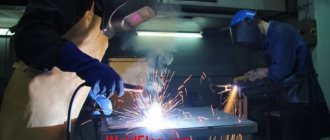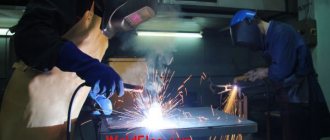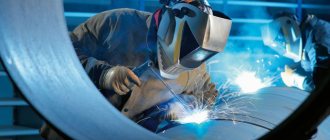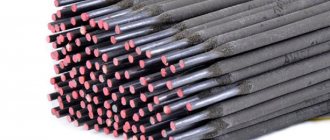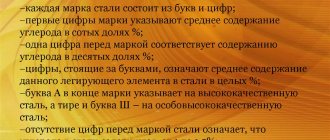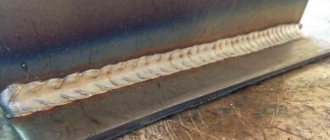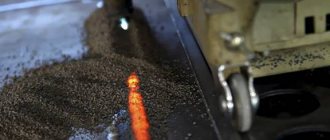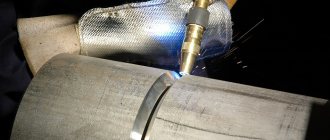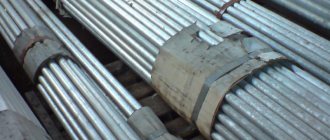Welding low alloy steels has found wide application in the manufacture of structures in construction. This is due to the fact that low-alloy structural steels have increased strength and, due to this, metal structures are lightweight and, therefore, more economical.
As a rule, the weldability of low-alloy structural steels is satisfactory. But, it is necessary to take into account that when the carbon content in the steel composition is more than 0.25%, there is a risk of the formation and development of hardening structures and hot cracks in the weld. In addition, other weld defects, such as the formation of pores, are likely to occur. And this happens due to carbon burnout during welding.
Marking features
Manufacturing standards and grades of low-alloy steels are determined by GOST 19282-73. It is used to work with rolled, wide-band, thick-sheet materials; the processing method is not important (it can be a shape, forging, stamping, etc.). Steel alloys are used in the construction of buildings, welding, assembling various structures, and in mechanical engineering.
According to GOST, the marking must indicate the following data:
- a group of numbers at the very beginning - indicates the percentage of carbon in steel;
- a letter for the alloying element, numbers indicating its percentage content (when less than 1%, the number is not indicated at all).
Example of marking on alloy 18ХГТ:
- carbon parts – 0.18%;
- manganese;
- chromium;
- titanium.
Since the numbers are not indicated, the remaining elements in the alloy are no more than 1%.
High quality welding of structural steels
Manual arc welding is excellent for welding joints of such metal alloys. In this case, electrodes E44A and E50A can be used. If you want to make the most durable, high-quality connection, use electrodes of the DSK-50 and UONI 13/55 brands. To increase the strength of the connection, it is also recommended to work on direct current with reverse polarity. Welding is carried out at reduced welding current levels, when 1 millimeter of electrode diameter accounts for about 50 Amperes of power. When using arc welding technology, suitable welding wire and additional flux are used to join low-alloy steel.
Please note that welding work can be carried out at temperatures not lower than -10 degrees. In the same case, if there is a need to perform work at lower temperatures, high-quality additional heating is necessary. In this case, the width of the heating zone on both sides of the connecting seam is about 100 millimeters. The optimal heating temperature is 150 degrees. At temperatures below minus 25 degrees, welding low-alloy steels is unacceptable.
Properties of alloys
Characteristics of the main alloying elements:
- Silicon is needed for alloying, it is inexpensive, the dependence of the hardness of the finished alloy on the volumetric inclusion of silicon in the composition is direct. The element is indispensable in the smelting of construction steels; it can be used with manganese and other components.
- Tungsten and molybdenum are needed to increase thermal resistance; they are used if the finished structures or products will be constantly operated at elevated temperatures.
- Vanadium is an important element in the complex alloying process; it makes it possible to obtain alloys with a uniform structure.
- Chromium is responsible for the resistance of steel to corrosion and the degree of its hardness. Titanium, nickel, and molybdenum increase stability; chromium can be replaced with these components.
- Copper is an element that is responsible for the degree of ductility of finished materials. There should not be too much of it, otherwise the alloy steel alloy will begin to stick to other working surfaces. For structural steels used in areas of high friction, this is a big disadvantage.
Also, low-alloy steels differ in types of processing. Thermal influences - tempering, hardening, tempering, normalization, they can be used in different combinations. Annealing parameters and weldability properties also differ.
To recognize the markings, you need to take into account the first letters used to designate the product range. Zh, X, E - this is a magnetic, chromium or stainless group. C – chromium-nickel, with pronounced stainless properties. Those alloys that are classified as high-speed, ball bearing alloys are designated as P or Sh.
A and Sh are high quality alloys. For normal quality such letters are not used. Materials produced by the rolling method have a special designation - this is TO or N, that is, heat treatment or cold hardening, respectively. The exact chemical composition of different brands is described in GOSTs and specialized literature. Understanding the basic principles of alloy marking will allow you to understand the composition of materials at the so-called household level.
High alloy
Highly alloyed alloys usually contain at least 16% chromium and at least 7% nickel, in addition to other impurities. Thanks to these and other additives, high-alloy alloys are highly resistant to low temperatures, corrosion and high temperatures.
But each brand has its own specialization, in which it has extreme characteristics. According to their purpose, high-alloy steels can be divided into heat-resistant, heat-resistant and corrosion-resistant.
After heat treatment they increase their strength and ductility. When hardened, their ductile properties improve.
Specificity
High-alloy alloys have such outstanding characteristics that they are used wherever the feasibility and price of the product allows.
But each specific product has different requirements. Accordingly, when carrying out welding work, different requirements for strength and ductility are imposed on welded seams, which leads to different approaches to welding work. That is, everything here is individual.
The presence of a large number of approaches in welding high-alloy steels is due to the fact that they have very specific thermophysical properties.
They have a low coefficient of thermal conductivity and a high coefficient of thermal expansion. In combination, they place conflicting demands on the welding process.
Low thermal conductivity leads to an increase in the depth of steel penetration. A high coefficient of thermal expansion causes deformation, including warping of parts. To reduce warping, it is necessary to concentrate thermal energy as much as possible. Laser welding does this well.
When manual electric welding of high-alloy alloys, the same measures are carried out as when welding medium-alloy alloys. The main task is to minimize the entry of hydrogen into the welding zone, otherwise it causes the appearance of pores and cracks.
Choice of technology
For high-alloy alloys, gas welding is not recommended for acid-resistant steels, as it causes intergranular corrosion. Even when heat-resistant steels are used in welding, warping of products occurs.
Submerged arc welding has great advantages over manual electric arc welding due to the fact that the welding process takes place under protection in a constant environment with the same components. There is no need to change electrodes, which causes crater formation.
Submerged arc welding ensures a uniform weld with specified characteristics due to the protection of the weld pool from the external environment in the form of hydrogen.
In addition, preliminary work is reduced, since cutting edges is only necessary for thicknesses of more than 12 mm, and manual arc welding requires cutting edges for metal thicknesses of more than 5 mm.
Laser welding is the most effective for alloy steels due to the high concentration of energy in a small area. This allows you to virtually eliminate warping and deformation. Many alloyed alloys can be welded together, regardless of type, only when using laser welding.
Where are low alloy steels used?
The use of low-alloy steels depends largely on their composition.
We will first consider main gas and oil systems. To construct them, we use the straight-seam electric welding method. The raw materials for the manufacture of products are mixtures with a low content of chromium and aluminum - up to a maximum of 0.3 and 0.05%, respectively.
13X steels are used for tools and special equipment. The calcination of the alloy is not very good; heat treatment above 250 degrees is not used.
To produce high-quality reinforcement for use in the construction industry, alloys of classes C, GS, KhGAYu, etc. are used. They are suitable for reinforcing reinforced concrete structures with different load-bearing parameters. To create reliable welded joints, it is optimal to use the types AFD, AFYu, GS. Complex buildings are made using alloys like 12KhGN2MFBAYU. The latter type of steel must first be hardened, then low tempered.
In mechanical engineering
- Manganese alloy 09G2 for creating frames, I-beams, and center-type beams. Operating temperature conditions – +450°.
- Manganese steel 10G2S1 for vessels and boilers that operate under pressure.
- Alloys with copper 10KhNDP are indispensable in the creation of complex machine-building structures.
- Manganese-copper low-alloy steel alloys types 12G2SMF can withstand any load and are indispensable in the construction of lightweight span structures.
A separate issue is the choice of steels for operation in constantly unfavorable conditions, that is, during precipitation and low air temperatures. Grades produced in accordance with GOST 19282 withstand such influences. Such steels are not afraid of corrosion, destruction, and are not subject to other negative changes.
Weldability of low alloy steels
To low alloy
include steels that are alloyed with one or more elements with a content of each of them ≤2% and a total content of alloying elements ≤5%. These steels are divided into three groups: low-carbon structural steels; heat resistant; medium carbon structural.
Low carbon low alloy
Structural steels can, in turn, be divided into high-strength and high-strength steels. In high-strength steels (NL1, NL2, 10G2SD, 14KhGS, 10KhSND, 12KhGN, 09G2DT, etc.) the carbon content does not exceed 0.23%. These steels are used in mechanical engineering and construction. They are supplied mainly in hot-rolled form.
Alloying elements - Mn, Si, Ni, Cr, Cu, Ti - dissolve in ferrite, strengthen it and grind pearlite. Thanks to this, the strength characteristics of such steels increase and the tensile strength reaches 55 kg/mm2.
In terms of their weldability, steels of this group differ little from unalloyed low-carbon steels. However, they are more prone to grain growth in the heat-affected zone, and at high cooling rates, nonequilibrium quenching structures may appear in it.
Low carbon high strength
steels (14Kh2GMR, 14KhMNDFR, 16G2AF, 12KhG2SMF, etc.) are classified as heat-hardening steels, which, along with high strength (σв ≥ 80 kg/mm2), are characterized by sufficient ductility, toughness, increased resistance to brittle fracture, corrosion resistance, etc. Application The use of such steels in mechanical engineering and construction can significantly reduce the weight of structures and increase their load-bearing capacity. Strengthening of these steels is achieved by a combination of minimal alloying and heat treatment - usually quenching and tempering. This creates a very fine structure with finely dispersed reinforcing particles of carbides or nitrides.
However, the weldability of high-strength steels is worse than the weldability of low-carbon, low-alloy steels, since:
1) cold cracks may form in the heat-affected zone of welded joints; 2) in the heat-affected zone, a softening area is likely to appear, reducing the strength of the welded joint.
Due to the presence of alloying elements that increase the stability of austenite, these steels are sensitive to the cooling rate. But the danger of cold cracks in the heat-affected zone is less here than in carbon structural steels, since the martensitic (or bainitic) transformation, due to the low carbon content, occurs at relatively high temperatures (> 350 °C) and is accompanied by relatively low stresses of the second kind ( microstresses). In addition, the low-carbon acicular martensite, or bainite structure, is more ductile. Yet. Since these structures have a reduced permeability to hydrogen, hydrogen diffusing from the weld accumulates at the boundaries of grains that have a disordered structure with a higher concentration of defects and distortions, and creates additional microstresses that contribute to the appearance of cold cracks. Reducing the cooling rate in the heat-affected zone, as well as means to reduce the amount of hydrogen dissolved in the metal of the weld pool, makes it possible to obtain a metal that is resistant to cold cracks.
Fig. 190. Distribution curves along the length of zone l of hardness in a welded joint made of heat-strengthened steels.
Softening in the thermally affected zone, accompanied by a drop in hardness (Fig. 190), can reach 30% or more. Its appearance is associated with the action of welding heating and concerns those areas of the zone whose maximum heating temperature lies within 500 °C - Аss (areas of recrystallization and incomplete recrystallization). Most often, softening is associated with two processes: 1) decomposition of a supersaturated solid solution and its depletion of strengthening alloying elements; 2) the formation of carbide phases and their coagulation. The degree of softening depends on the chemical composition of the steel and its heat treatment and increases with increasing welding heat input: in Fig. 190 curve 1 is presented for steel 14KhMNDFR (qp - 8000 cal/cm); curve 2 is for 15KhSND (qp - 7500 cal/cm), and curve 3 is for 15KhND steel (qp - 12,000 cal/cm).
Softening can be significantly reduced and even eliminated by increasing the cooling rate during welding. However, in this case, the possibility of the appearance of hardening structures in the heat-affected zone should be taken into account. Therefore, the thermal cycle when welding heat-hardening steels should be regulated very carefully.
Heat-resistant low-alloy
steels (15M, 15KhMA, 20KhMA, 20KhMFL, etc.) have increased technical strength at high temperatures and long-term constant loads. Their heat resistance is assessed by the value of the creep limit (Creep is the ability of a metal heated to a high temperature to gradually deform plastically under the influence of a long-term constant load. Hence the creep limit is the stress at which, after a certain period of time at a given temperature, the creep deformation will receive a predetermined value) and the long-term limit strength (The long-term strength limit is the minimum stress that causes destruction of the metal at a given temperature over a certain period of time (1000 hours, 10,000 hours, etc.)). These steels are used for the manufacture of structures operating at high temperatures (350-450 °C) and significant stresses, as well as in environments that promote chemical and mechanical destruction of the metal (steam boilers, oil equipment, etc.). Usually, such steels are used to increase Their heat resistance is enhanced by special alloying elements (Mo, V, W). which increase the temperature of softening of the metal when heated and the resistance of the metal to softening. To simultaneously increase the heat resistance of steel, Cr is introduced into its composition, which creates a protective film of oxides on the surface of the metal (heat resistance - resistance to oxidation at high temperatures). Heat-resistant steels are used, as a rule, after heat treatment (normalization with tempering, hardening with tempering, etc.).
Steels of this group have satisfactory weldability. However, in this case it is necessary to obtain a weld metal that is close in composition to the base metal in order to prevent the development of diffusion processes under high temperature conditions. This ensures the required strength of the weld metal and the base metal.
Heat-resistant low-alloy steels are characterized by increased sensitivity to hardening. Therefore, metastable brittle martensite structures and cold cracks can form in the heat-affected zone. To create conditions in the metal being welded under which the heat-affected zone would cool at a rate not exceeding the permissible rate, preheating of the product is used. The heating temperature and welding mode are determined by appropriate calculations. Typically, the heating temperature of chrome-molybdenum heat-resistant steels lies in the range of 200 - 300 °C. After welding, all products made from heat-resistant low-alloy steels are subjected to heat treatment (usually normalization with tempering, sometimes high tempering to level the structure and relieve welding stresses).
Medium carbon low alloy
Structural steels (25KhGSA, ZOKHGSA, 35KhM, etc.), most widely used in mechanical engineering, are used mainly in heat-treated form. Such steels have high mechanical properties, especially strength characteristics (σв = 80 ÷ 110 kg/mm2).
The weldability of medium-carbon low-alloy steels is significantly worse than the steels of the previously considered groups, which is associated with the increased tendency of the weld metal and heat-affected zone to form cracks. The weldability of these steels has many similarities with the weldability of medium-alloy pearlitic steels.
Medium alloy steels
Medium alloy steels contain carbon in amounts of 0.4% or more. They are alloyed mainly with Ni, Mo, Cr, V, W. The optimal combination of strength, toughness and ductility is achieved after hardening and low tempering. Medium alloy steels such as KhVG, KhVSG, 9HS are in great demand due to their alloying additives in the manufacture of drills, reamers and broaches.
These steels are smelted from pure charge materials to increase ductility and toughness. They are also carefully cleaned from phosphorus, sulfur, gases and various non-metallic inclusions. In this case, steel can be subjected to electroslag or vacuum-arc remelting, or refining in a ladle with liquid synthetic slag. A good combination of strength, toughness and ductility of medium-alloy steels is achieved by thermomechanical processing.
Welding technology for medium alloy metals
To ensure the operational reliability of welded joints, when choosing welding materials, it is necessary to strive to obtain welds of such a chemical composition that their mechanical properties would have the required values. degree of change in these properties depends on the share of participation of the base metal in the formation of the weld. Therefore, you should choose welding materials that contain less alloying elements than the base metal. Alloying the weld metal at the expense of the base metal makes it possible to increase the properties of the weld to the required level.
When welding medium-alloy, deeply hardening, high-strength steels, it is necessary to select welding materials that will ensure the production of welds with high deformation capacity with the minimum possible amount of hydrogen in the weld pool. This is achieved by using low-alloy welding electrodes that do not contain organic substances in the coating and are subjected to high-temperature calcination. At the same time, when performing welding work, other sources of saturation of the weld pool with hydrogen (moisture, rust, etc.) should be excluded.
Austenitic welding consumables are widely used for welding medium-alloy steels. For mechanized welding and the manufacture of electrode rods, GOST 2246-70 provides for wire grades Sv-08Х20Н9Г7Т and Sv-08Х21Н10Г6, and GOST 10052-75 - electrodes of type EA-1G6, etc. Electrode coatings are used of type F, and for mechanized welding - basic fluxes. For welding medium-alloyed high-strength steels, electrodes of types E-13X25N18, E-08X21N10G6 and others are used in accordance with GOST 10052-75 and GOST 9467-75.
High quality welded joints with a thickness of 3...5 mm are achieved using argon arc welding with a non-consumable electrode. At the same time, to increase the penetrating ability of the arc, activating fluxes (AF) are used. Welding with AF is effective with mechanized methods to obtain a uniform penetration depth. The non-consumable electrode when welding with AF is selected from the most resistant grades of activated tungsten.
Gas welding of alloy steels is carried out with oxygen acetylene, which provides a high-quality weld. Substitute gases are not recommended in this case. But even oxygen acetylene cannot completely guarantee a high-quality seam. This can only be achieved by using arc welding.
Do-it-yourself metal doors are the ideal solution if you want to save money. Steel hardening is an obligatory stage in mechanical engineering, since the quality of the product depends on the correctness of its implementation. Read more in this article.
You can make very beautiful products from metal. You will find interesting ideas at https://elsvarkin.ru/prakticheskoe-primenenie/suveniry-i-ukrasheniya-iz-metalla-svoimi-rukami/ link.
Heat treatment and straightening of products after welding
Heat treatment is used to eliminate stresses remaining in the product after welding, as well as to improve the structure of the weld metal. After welding or during the welding process, types of heat treatment such as annealing, normalization, and tempering are used.
Heating during annealing of the product in the furnace is carried out gradually. For low-carbon and medium-carbon steels, the temperature reaches 600 ... 680 °C. At this temperature, the steel becomes plastic and stresses are reduced. After heating, it is held at the reached temperature at the rate of 2.5 minutes per 1 mm of thickness of the part being welded, but not less than 30 minutes. Then the product is cooled along with the oven. There are other types of annealing - local and complete. Annealing modes are selected from reference literature depending on the steel grade.
Rice. 1. Scheme of straightening a part using local heating : 1, 2 - part before and after straightening, respectively; 3 - heating zone
Normalization differs from annealing in that after annealing the welded structure is cooled in still air. After normalization, the fine-grained structure of the metal is preserved, which makes it possible to ensure its relatively high strength and hardness, but without a stressed state.
When gas welding steels, heat treatment serves to increase the ductility of the weld metal. In some cases, sections of the seam are heated to a light red heat and in this state they are forged. The metal grains are crushed, ductility and viscosity increase. To avoid the appearance of hardening (a new stressed state), forging should be stopped when the metal cools to a dark red color. After forging, it is necessary to re-normalize.
| Table 5. Modes for straightening carbon steel sheets using an oxygen-acetylene flame | ||||
| Sheet thickness, mm | Burner tip number according to GOST 1077 - 79E | Heating rate, °C/min | Heating zone width, mm | |
| visible* | actual | |||
| 2 | 3 | 420 | 15 | 20 |
| 3 | 4 | 380 | 15 | 20 |
| 4 | 5 | 270 | 20 | 35 |
| 5 | 6 | 240 | 20 | 35 |
| 6 | 6 | 180 | 30 | 55 |
*At temperatures above 600 °C.
Rice. 2. Scheme for straightening a steel sheet 15 mm thick : I - IV - heating strips; — — — — sheet condition before editing
To straighten products, local heating with a burner flame is often used. Heat the convex part of the product that needs to be straightened (Fig. 1). When heated, the metal tends to expand, but since cold areas prevent this, compressive stresses arise, causing plastic compressive deformation. When cooled, tensile stresses arise in this area, causing the product to straighten.
If repeated straightening is necessary, the next section is heated without affecting the adjacent one, which has already been heated. In table Figure 5 shows approximate modes for straightening carbon steel sheets with an oxygen-acetylene flame.
Thick sheet metal after cutting on blanking shears has a pronounced convexity. Straightening is carried out by heating according to the scheme shown in Fig. 2.
